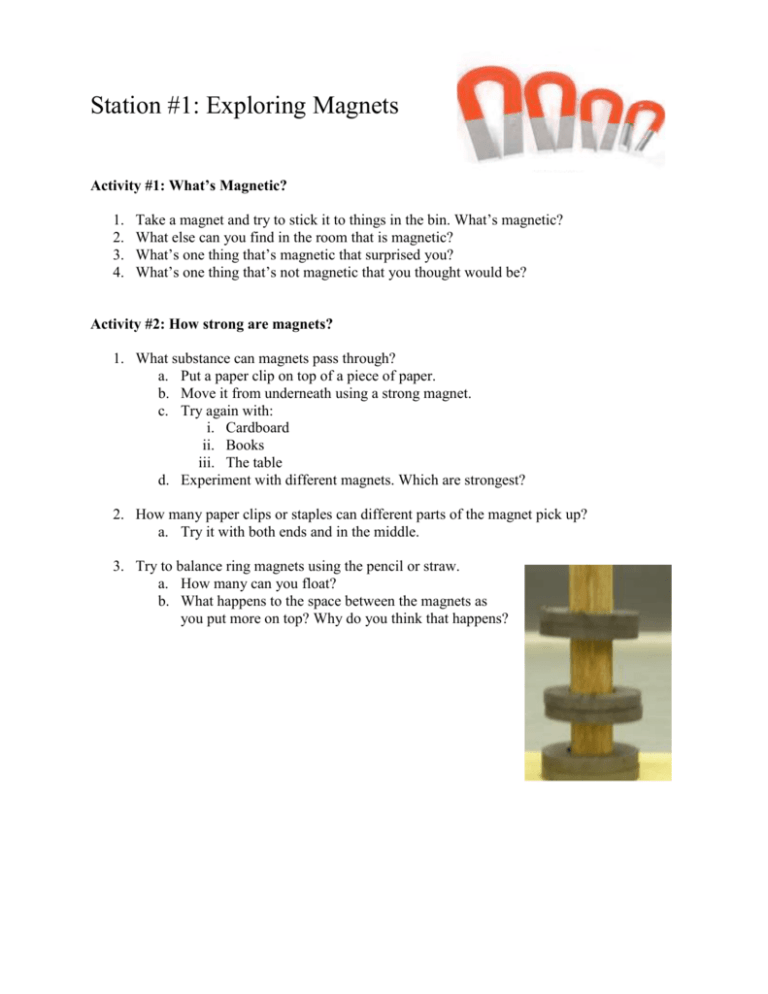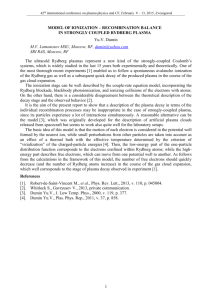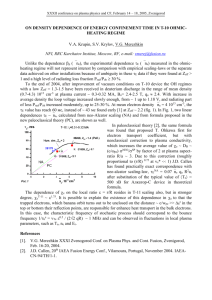PlasmaStations
advertisement

Station #1: Exploring Magnets Activity #1: What’s Magnetic? 1. 2. 3. 4. Take a magnet and try to stick it to things in the bin. What’s magnetic? What else can you find in the room that is magnetic? What’s one thing that’s magnetic that surprised you? What’s one thing that’s not magnetic that you thought would be? Activity #2: How strong are magnets? 1. What substance can magnets pass through? a. Put a paper clip on top of a piece of paper. b. Move it from underneath using a strong magnet. c. Try again with: i. Cardboard ii. Books iii. The table d. Experiment with different magnets. Which are strongest? 2. How many paper clips or staples can different parts of the magnet pick up? a. Try it with both ends and in the middle. 3. Try to balance ring magnets using the pencil or straw. a. How many can you float? b. What happens to the space between the magnets as you put more on top? Why do you think that happens? Station #2: Magnetic Fields Activity #1: Magnetic Fields 1. Look at the fields created by magnets using the field viewers. (The field viewers are just iron filings in oil.) 2. Try it with two or three magnets and see what patterns you can make. 3. Sketch the field patterns on a piece of paper. Activity #2: Build a compass 1. Try to pick up a staple using a needle. Does it work? 2. Stroke the needle with a strong magnet 30 times in the same direction. Now try to pick up the staples. What happens? 3. Stick the needle into a piece of Styrofoam. 4. Carefully float it in a cup of water. Compare it to the compass. What direction does it point? 5. If it doesn’t work, try stroking the needle again with the magnet. Station #3: Plasma A plasma is created whenever atoms of a gas are heated up so they are extremely hot. The atoms have so much energy that when they collide, the electrons get knocked off. Therefore, a plasma is a bunch of electrons and ions (atoms missing their electrons). Plasma Ball The plasma ball is a miniature Tesla coil. Inside the ball is a coil of wires that have electrons going through them oscillating at a very high frequency. This shakes the atoms around the wires so hard that their electrons start to fall off! Inside the glass globe is a partial vacuum. This just means that some of the air has been sucked out. Because there is not as much air in there, it is easier to make electric sparks that can be seen. Try This: 1. Put your hand on the plasma ball. What happens? 2. Now bring the fluorescent light tube close to the plasma ball. What happens? 3. This step requires a friend, so have one close by and ready to help. Stand on a chair or stool and put your hand on the ball. Now have your friend hand you the light tube. Do you see it light up? What happens if your friend lets go? Be careful to not touch the ends of the light tube – it gets hot! 4. Stand on the ground and try the #3 again. Does it work? 5. Put a penny on the top of the plasma ball. Carefully touch the penny with another penny. Don’t use your finger – you’ll get a shock! 6. Hold the magnet near the plasma ball. Do you see the plasma move? What’s going on? 1. The electrons repel each other and want to get as far away from each other as possible. They are always trying to reach the ground (because its so big, the electrons can get very far away from each other). They can get to the ground by traveling through you. 2. The tube lights up because some of the electricity gets through the glass ball. It’s enough to light up the fluorescent tube. (Also an example of how fluorescent lights use much less energy than incandescent bulbs!) 3. The electricity is going through you, into the light tube, and then through your friend into the ground. 4. It doesn’t work because the electricity goes into the ground and there’s not any left to light up the bulb. 5. Penny is a conductor and so electrons move easily through it. When enough electrons build up, they jump to the other penny and make a spark! 6. The electrons and ions in the plasma are repelled by the magnetic fields. This is an example of how electricity and magnetism are related. Station #4: Fusion Fusion occurs when two ions in a plasma collide with enough energy to merge together. This releases a lot of energy. Scientists would like to find a way to control fusion so we can use the energy that is released. We can use this energy for electrical power, which will make us less dependent on fossil fuels. Cookies as a Model for Fusion In this activity, cookies will act like atoms in a fusion reaction. Fusion occurs when heat is added to atoms, giving them enough energy to collide and stick together. In this case, the microwave will add the energy to heat the “atoms” (cookies). 1. 2. 3. 4. 5. Put two equally sized pieces of cookie dough on the wax paper, about 1 inch apart. Mass the cookies and write your measurement in the table. Put the cookies in the microwave for 1 minute (you’ll have to take turns). Let the cookies (your new element!) cool for 1 minute. Mass them again and record on your table. What’s the difference in mass before and after fusion (cooking)? 6. The missing mass is the energy released by fusion! How does this compare to real fusion? In real fusion… Atoms New element (2 atoms fused together) Heat energy from electromagnetic waves Mass lost is energy we can use. In the cookie experiment… Raw Cookies Baked cookie Heat energy from microwaves (which is an electromagnetic wave) Mass lost is due to water loss.






